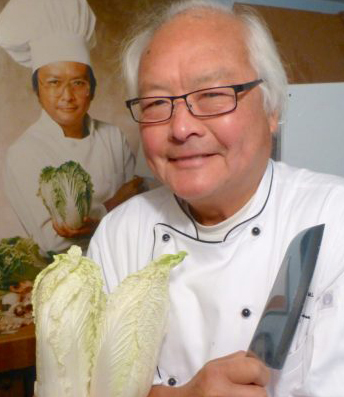Wok & Roll by Peter Kwong, (Frederic) Inter-County Leader
» Download this column as a Word document
The Chinese are not big beef eaters. After all, the farmers need the cows to help with the farm work.
Living in the cities, I read books about farm animals while I was growing up. The cows go “moo,” the pigs go “oink, oink,” the chickens go “cluck, cluck,” and the ducks go “quack, quack.”
Except in the markets, I never really saw or touched a live farm animal before. Maybe a few times when the farmers would hold an exhibition like our state fair and would show off their prize animals. I dared not pet them or get too close, worried that they might bite me. They do have teeth, don’t they?
As I grew older, I would go shopping with Pao Pao (my grandmother on my mother’s side). I was her favorite assistant as I was the strongest among all my cousins and I could carry more shopping bags on my shoulders.

Walking for hours carrying a heavy load and smelling all the animal wastes wasn’t my cup of tea, and Pao Pao knew it. She would bribe me with a bowl of my favorite noodle soup, won ton noodles, at the end of the shopping day. How could I refuse?
Anyway, I got used to seeing the ducks and chickens crowded in the bamboo cages, with their heads sticking out, checking out the environment, making more noise and adding more stench to the already foul-smelling market. Pao Pao never had the merchant clean the fowl, which was a common courtesy. She would do her own.
Usually, the merchant would slaughter the chicken/duck by slitting its throat, right in front of you. Then he would skillfully pluck the bird clean of feathers and even clean out the innards.
It is a tradition that the Chinese serve all the animals whole, especially chicken, duck, piglets and fish. It represents that one would start something and finish it, from beginning to end. A good symbol for marriages.
When they serve the dish, the juicy part would be facing the elders. Being the youngest, the head or tail always faced me. Life is not fair and who could I complain to?
My least favorite stalls in the marketplace were the meat department — cows, pigs, goats had been slaughtered and the pieces would be hanging for display, including the innards.
The worst part was they would leave the heads by the side of the stalls to be picked up later. Imagine a skinless head with eyeballs still staring at you. I would have nightmares for weeks.
Coming to the States, everything changed. Everything is sold in the store, nicely packaged. No more blood, no more foul smell and no need to negotiate with the merchant about prices. Take it or leave it is the mentality. I like that.
Anyway, I recently met with Barb and Mike Swank, the owners of Swank’s Meats in St. Croix Falls. Amazed at just how many different cuts of beef there are, I asked him to help me out so I could have a better understanding. Mike patiently walked me through the different cuts and the recommended cooking methods. So, I will relate his wisdom to you.
First, there are six ways to cook beef:
- Grill or broil (GoB)
- Stir fry (SF)
- Skillet (Sk)
- Slow cooking (SC)
- Roast (R)
- Skillet to oven (StO)
Get it? And all meats taste better if you marinate them first. (All chefs have their own secret marinade, ask me and I’ll share mine with you.)
There are eight basic cuts of beef:
- Chuck
- Brisket
- Rib
- Plate
- Loin
- Flank
- Sirloin
- Round
I will give a few examples of each cut, with the recommended cooking methods. Experiment with each and pick your favorites. The more expensive the cut of meat doesn’t always mean that it is the best. It is how you cook it that makes it everyone’s favorite.
Here it goes:
- Chuck – Chuck roast (SC), Denver steak (GoB) (SF) (Sk), country-style ribs (SC) or short ribs – bone-in (SC).
- Rib – Rib roast – bone-in (R), ribeye steak (S) (GoB), ribeye fillet (GoB) (StO).
- Loin – Porterhouse, T-bone strip steak (GoB) (Sk), tenderloin fillet (GoB) (StO).
- Sirloin – Sirloin steak (GoB) (Sk) (SF), tri-tip steak (GoB) (Sk) (SF).
- Round – Top round steak (GoB) (SF) (Sk), bottom round rump roast (SC) (R).
- Others – Stew meat (SC), ground beef (GoB) (Sk), shank (SC).
- Brisket – Brisket flat (SC).
- Skirt steak – (GoB) (Sk) (SF).
- Flank steak – (GoB) (SF).
There you have it. Not being a butcher myself, I did the best I could. If you have any questions or need some recipes, just call Mike at Swank’s. He’ll be more than happy to help you.
When I started working in restaurants many years ago, I had to dissect 10 cases of whole chickens at a time. There would be breasts, thighs and wings.
At the end of the shift, the chef would give me a dollar to take all the wings home, as they weren’t on the menu and he didn’t want to throw them in the garbage. Because of the success of buffalo wings, now the wings are $4 a pound.
Same with flank steak, it cost $1 for the whole flap. Then one chef used that to make Chinese stir-fry and Mexican fajitas; it was a big success and now the price has jumped up to $6 a pound.
So, experiment with it and have a great time. Bon appetite!



